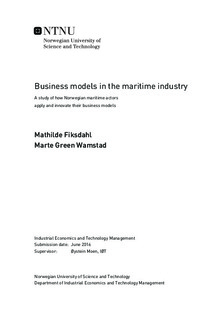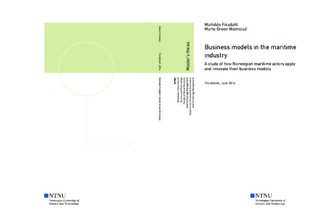| dc.description.abstract | An IBM survey from 2006 revealed that firms focusing on business model innovation exceeded their competitors in operating margin by five percent. The relevance of business model innovation can be regarded as interesting for maritime firms as the maritime industry is faced with continuous pressure for realignment. This thesis research question therefore sought to answer how Norwegian maritime actors apply and innovate their business models, and whether these approaches can be linked to profitability.
To answer this, a comprehensive industry and literature review was conducted. The maritime industry review was used to provide an overview of the industry s characteristics and the dynamics between its actors. The literature review consisted of two main building blocks; theories of the business model concept and theories of business model innovation. Based on the mentioned reviews, a framework was developed, where expectations to findings were presented. This framework have enabled the research question to be answered.
In this thesis, a case study has constituted the primary source of empirical evidence. The case study included five Norwegian maritime actors. The case actors represents different parts of the industry; shipping, shipyards and maritime equipment suppliers. Quantitative data and data from secondary sources have been additional empirical sources.
It has been found that value propositions, profit/revenue generation and value chain architecture are recurring components in the case actors business model definitions. In general, there still exists uncertainty regarding the content of the business model concept in the maritime business. The finding that two out of five case actors do not have a significant relation to their business model might illustrate this. As for the utilization of the business model, only one case actor uses their business model as a separated term in their strategic operations. With regards to how maritime actors innovate their business models, the case actors to a small extent use open networks as a source of innovation. There also seems to be a division between business model innovator strategies among the maritime actors, where two actors were considered incremental and two were seen as radical. A vague link has also been drawn between ideal business model innovation strategies and profitability.
This thesis has contributed with significant findings in the interface between the maritime industry and the fields of business models and business model innovations. Theoretical representations of business models in literature has shown to be relevant in practice. The thesis has also revealed a gap in the literature regarding a clear and tangible link between business model innovation and profitability. Lastly, it has been disproven that the same factors that enable Norwegian maritime actor s realignment abilities enable business model innovations. | |

